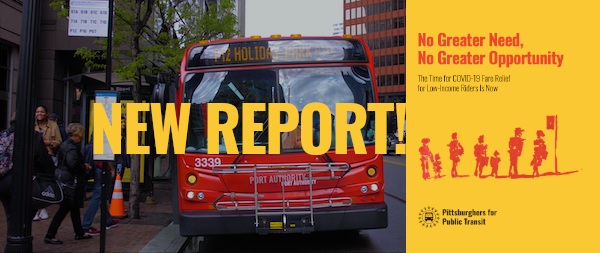
Pittsburgh PA – On Tuesday, September 22, Pittsburghers for Public Transit (PPT) published a new report detailing why the Port Authority should immediately implement a transit fare relief program for low-income riders titled “No Greater Need, No Greater Opportunity: The Time for COVID-19 Fare Relief for Low-Income Riders is Now.”
This new report lays out how collecting full fares during the pandemic is disproportionately harming Allegheny County’s low-income and Black residents, and preventing these residents from accessing basic needs including groceries, healthcare and jobs. Emergency fare relief is in line with measures being taken by other public utility providers, to ensure that connections to critical services are not cut off in the midst of an unprecedented economic and public health crisis.
Port Authority has stated that they are interested in a long-term low-income fare program. There is no better time to pilot its implementation. Transit agencies are facing an existential ridership crisis, with no clear pathway to recovering the 65-70% of pre-COVID-19 ridership that has stopped taking transit. Allowing SNAP-eligible riders to show their EBT/ACCESS cards to board could provide an immediate ridership boost without incurring increased operating costs.
In May, PPT mobilized 31 riders and organizational speakers to call for this COVID-related intervention at Port Authority’s board meeting, when it became clear that the agency was planning to reinstate full fare collection after a 2-month hiatus.
19 local and state political leaders followed suit with a letter to Port Authority calling for fare relief for low-income riders, and Allegheny County Council passed a Will of Council advocating for the measure.
Key Findings from Pittsburghers For Public Transit’s new report, “No Greater Need, No Greater Opportunity: The Time for COVID-19 Fare Relief for Low-Income Riders is Now.”
- Black residents and low-income residents represent a disproportionately high percentage of transit ridership during COVID-19.
- Transit routes serving Black neighborhoods have seen steep ridership losses from the reinstatement of full fares.
- Port Authority Transit ridership is at an all-time low (down 65-70%), and an emergency low-income fare program could allow PAAC to quickly regain 9% of its ridership.
- Port Authority can implement the program with little to no increase in operating costs by reallocating service to high-ridership routes (which Port Authority announced it would begin doing in November).
- Unique revenue sources that could cover the estimated annual fare revenue loss of $4M-$8M include: The $141M in CARES Act Funding received by the Port Authority, Cares Act Funding received by the County and/or State, philanthropic partner support for emergency COVID relief efforts.